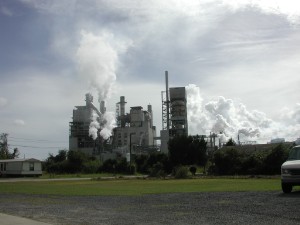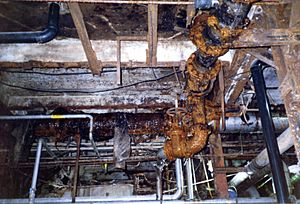Paper mill facts for kids


A paper mill is a factory where paper is made. They use materials like wood pulp (which comes from trees) and old rags. Before big machines were invented, paper was made by hand, one sheet at a time. This was done by special workers.
Contents
History of Paper Mills

It can be tricky to find out exactly when paper mills started. This is because old writings sometimes called any place that made paper a "mill." They did not always say if it used people, animals, or water for power. It is hard to know which mills were the most important water-powered ones.
Early Mills: People and Animals
People in Muslim and Chinese areas used mills powered by humans and animals. But there is not much proof of water-powered paper mills before the 11th century. Early Muslim writers often called paper-making places "paper manufactories," not "mills." This suggests they did not use water power much.
Scholars have found records of paper mills in Baghdad around 794–795. But it is debated if these used water power. In Fez, Ibn Battuta wrote about "400 mill stones for paper." This large number likely means they were powered by humans or animals, not water.
Water-Powered Mills Emerge
Some early writings hint at water-powered mills. For example, a Persian scholar named Abū Rayḥān al-Bīrūnī mentioned something in Samarkand in the 11th century. But it is not clear if it was a water-powered paper mill.
Clear proof of a water-powered paper mill comes from 1282 in Aragon, Spain. King Peter III ordered a proper water mill (a "molendinum") to be built. This was in Xàtiva, a place known for making paper. This early mill was run by Muslims. However, some local paper makers did not like it. The king's order allowed them to keep making paper by hand. It also let them avoid working in the new mill.
The first lasting paper mill north of the Alps was built in Nuremberg in 1390. It was started by Ulman Stromer. This mill was later shown in the famous Nuremberg Chronicle. From the mid-1300s, paper making in Europe got much better.
Before industrial machines, the size of a paper mill was counted by its vats. A "one vat" mill had one vatman, one coucher, and other workers.
Paper Mills in the 20th Century
By the early 1900s, many paper mills opened. They were in places like New England and around the world. This was because people needed a lot of paper. The Brown Company in Berlin, New Hampshire was a big paper producer. In 1907, this company cut down millions of acres of trees.
In the 1920s, Nancy Baker Tompkins helped sell paper for large companies. Her business, started in 1931, was unique. It did well even during a tough economic time.
Logs were often sent to the mills by "log drives" down rivers. By the late 1900s and early 2000s, many paper mills closed. Log drives also became less common. New machines meant fewer workers were needed. This led to many historic paper mills shutting down.
How Modern Paper Mills Work
Paper mills can be "integrated" or "nonintegrated." Integrated mills have both a pulp mill and a paper mill in the same place. These mills take in logs or wood chips and turn them into paper.
Modern paper mills use a lot of energy, water, and wood pulp. They have complex processes to make paper. They also use special technology to control everything. This helps them make paper that can be used in many ways. Modern paper machines can be over 500 feet (150 meters) long. They can make a sheet of paper 400 inches (10 meters) wide. They also run at speeds of more than 60 miles per hour (97 km/h). The main companies that make these machines are Metso and Voith.
Images for kids
See also
 In Spanish: Fábrica de papel para niños
In Spanish: Fábrica de papel para niños




